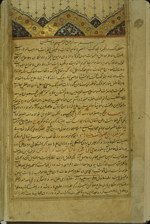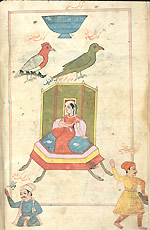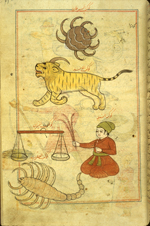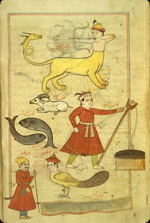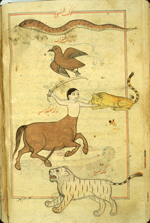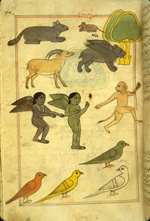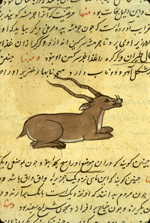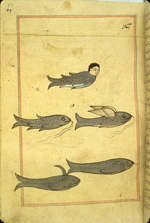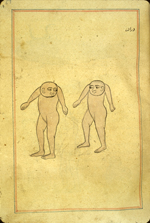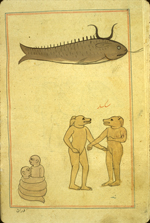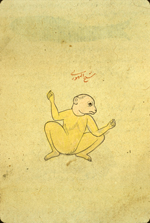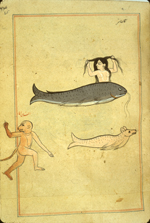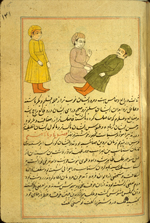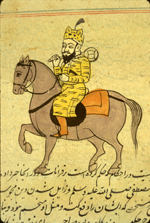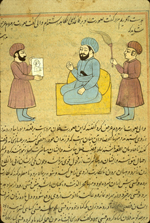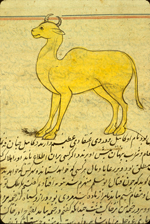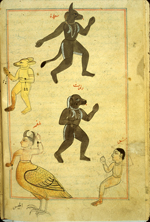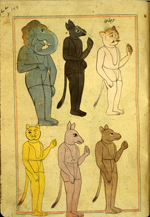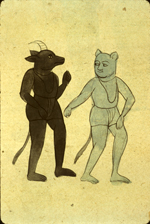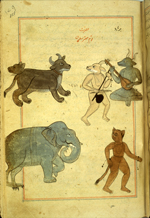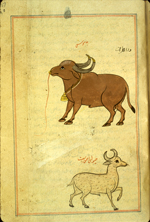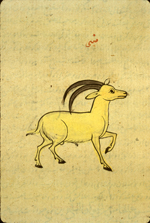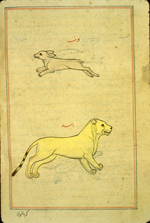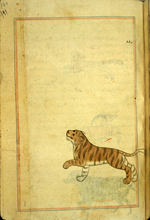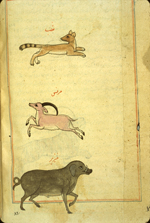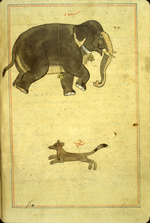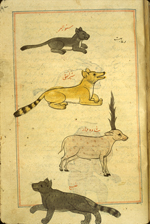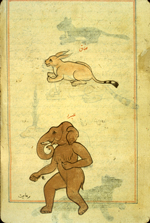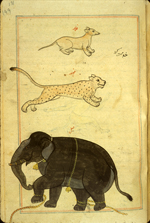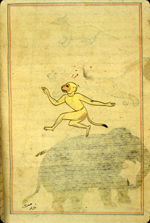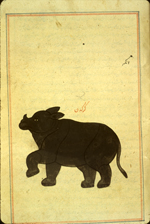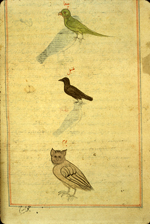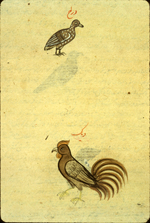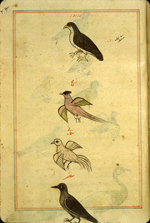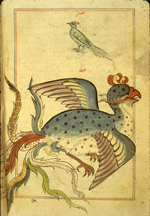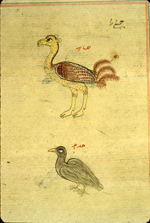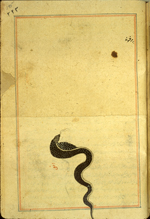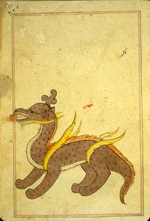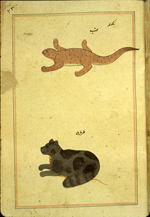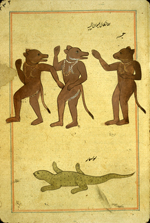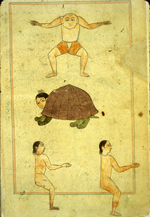Catalogue: Natural History
-
 ‘Ajā’ib al-makhlūqāt wa-gharā’ib al-mawjūdāt (MS P 2)
‘Ajā’ib al-makhlūqāt wa-gharā’ib al-mawjūdāt (MS P 2) - (Marvels of Things Created and Miraculous Aspects of Things Existing)
- كتاب عجائب المخلوقات وغرائب الموجودات
- by Zakarīyā’ ibn Muḥammad al-Qazwīnī
- زكرياء ابن محمد القزوينى
Illustrations
The illuminated headpiece opening a copy of ‘Ajā’ib al-makhlūqāt wa-gharā’ib al-mawjūdāt (Marvels of Things Created and Miraculous Aspects of Things Existing) by al-Qazwīnī (d. 1283/682). Neither the copyist nor illustrator is named, and the copy is undated. The nature of paper, script, ink, illumination, and illustrations suggest that it was produced in provincial Mughal India, possibly the Punjab, in the 17th century.
Six constellations of the northern skies: Corona Borealis (al-fakkah, in Arabic), Cygnus (al-dajajah) shown here as a crested bird, and Lyra depicted as a green parrot, with Cassiopeia seated on a throne in the middle, and Perseus (bottom right) and Boátes (bottom left). From a copy of ‘Ajā’ib al-makhlūqāt wa-gharā’ib al-mawjūdāt (Marvels of Things Created and Miraculous Aspects of Things Existing) by al-Qazwīnī (d. 1283/682). Neither the copyist nor illustrator is named, and the copy is undated. The nature of paper, script, ink, illumination, and illustrations suggest that it was produced in provincial Mughal India, possibly the Punjab, in the 17th century.
Five zodiacal constellations: Cancer, Leo, Libra, Virgo (a man sitting cross-legged with a sheaf of wheat in his right hand), and Scorpio. From a copy of ‘Ajā’ib al-makhlūqāt wa-gharā’ib al-mawjūdāt (Marvels of Things Created and Miraculous Aspects of Things Existing) by al-Qazwīnī (d. 1283/682). Neither the copyist nor illustrator is named, and the copy is undated. The nature of paper, script, ink, illumination, and illustrations suggest that it was produced in provincial Mughal India, possibly the Punjab, in the 17th century.
Eight constellations (from the top): Sagittarius, Capricorn, Aquarius (a large figure drawing water from a well), Pisces, Cetus (a harpy with a peacock's tail), Orion (a standing turbaned male with sword and shepherd's staff), and the constellation Eridanus (the River). From a copy of ‘Ajā’ib al-makhlūqāt wa-gharā’ib al-mawjūdāt (Marvels of Things Created and Miraculous Aspects of Things Existing) by al-Qazwīnī (d. 1283/682). Neither the copyist nor illustrator is named, and the copy is undated. The nature of paper, script, ink, illumination, and illustrations suggest that it was produced in provincial Mughal India, possibly the Punjab, in the 17th century.
Five southern constellations (from the top): Hydra, Corvus, Centaurus with Lepus (usually a hare, but here a yellow long-tailed cat), and, at the bottom, Lupus (al-sab‘, a wild beast) shown as a pink tiger. From a copy of ‘Ajā’ib al-makhlūqāt wa-gharā’ib al-mawjūdāt (Marvels of Things Created and Miraculous Aspects of Things Existing) by al-Qazwīnī (d. 1283/682). Neither the copyist nor illustrator is named, and the copy is undated. The nature of paper, script, ink, illumination, and illustrations suggest that it was produced in provincial Mughal India, possibly the Punjab, in the 17th century.
Creatures from the Island of Zanj (jazirah-i Zanj), including gray and green winged humanoids. From a copy of ‘Ajā’ib al-makhlūqāt wa-gharā’ib al-mawjūdāt (Marvels of Things Created and Miraculous Aspects of Things Existing) by al-Qazwīnī (d. 1283/682). Neither the copyist nor illustrator is named, and the copy is undated. The nature of paper, script, ink, illumination, and illustrations suggest that it was produced in provincial Mughal India, possibly the Punjab, in the 17th century.
A lion-headed humanoid laying prostrate, said to be an inhabitant of the 'Island of Atwaran', a mountainous island in the ocean inhabited by jinn, or demons. From a copy of ‘Ajā’ib al-makhlūqāt wa-gharā’ib al-mawjūdāt (Marvels of Things Created and Miraculous Aspects of Things Existing) by al-Qazwīnī (d. 1283/682). Neither the copyist nor illustrator is named, and the copy is undated. The nature of paper, script, ink, illumination, and illustrations suggest that it was produced in provincial Mughal India, possibly the Punjab, in the 17th century.
An oryx-like creature with small tusks, said to be associated with beasts of the sea. From a copy of ‘Ajā’ib al-makhlūqāt wa-gharā’ib al-mawjūdāt (Marvels of Things Created and Miraculous Aspects of Things Existing) by al-Qazwīnī (d. 1283/682). Neither the copyist nor illustrator is named, and the copy is undated. The nature of paper, script, ink, illumination, and illustrations suggest that it was produced in provincial Mughal India, possibly the Punjab, in the 17th century.
Five mythical sea creatures, including a human-headed fish and a winged fish. From a copy of ‘Ajā’ib al-makhlūqāt wa-gharā’ib al-mawjūdāt (Marvels of Things Created and Miraculous Aspects of Things Existing) by al-Qazwīnī (d. 1283/682). Neither the copyist nor illustrator is named, and the copy is undated. The nature of paper, script, ink, illumination, and illustrations suggest that it was produced in provincial Mughal India, possibly the Punjab, in the 17th century.
Two figures with heads on their chests, looking at each other. They are said to be inhabitants of a remote island near the limit of the inhabited world. From a copy of ‘Ajā’ib al-makhlūqāt wa-gharā’ib al-mawjūdāt (Marvels of Things Created and Miraculous Aspects of Things Existing) by al-Qazwīnī (d. 1283/682). Neither the copyist nor illustrator is named, and the copy is undated. The nature of paper, script, ink, illumination, and illustrations suggest that it was produced in provincial Mughal India, possibly the Punjab, in the 17th century.
A sea-creature, two dog-headed humans talking, and a group of snake-humans-all said to be amongst the inhabitants of a remote island near the limit of the inhabited world. From a copy of ‘Ajā’ib al-makhlūqāt wa-gharā’ib al-mawjūdāt (Marvels of Things Created and Miraculous Aspects of Things Existing) by al-Qazwīnī (d. 1283/682). Neither the copyist nor illustrator is named, and the copy is undated. The nature of paper, script, ink, illumination, and illustrations suggest that it was produced in provincial Mughal India, possibly the Punjab, in the 17th century.
A yellow monkey (labeled shaykh al-huri, 'master of the fishing-boat'), in the chapter on strange creatures of the sea. From a copy of ‘Ajā’ib al-makhlūqāt wa-gharā’ib al-mawjūdāt (Marvels of Things Created and Miraculous Aspects of Things Existing) by al-Qazwīnī (d. 1283/682). Neither the copyist nor illustrator is named, and the copy is undated. The nature of paper, script, ink, illumination, and illustrations suggest that it was produced in provincial Mughal India, possibly the Punjab, in the 17th century.
Above: a woman with long hair behind a large gray fish. Below: a monkey (labeled insan al-ma', 'aquatic being') and a pink fish. From a copy of ‘Ajā’ib al-makhlūqāt wa-gharā’ib al-mawjūdāt (Marvels of Things Created and Miraculous Aspects of Things Existing) by al-Qazwīnī (d. 1283/682). Neither the copyist nor illustrator is named, and the copy is undated. The nature of paper, script, ink, illumination, and illustrations suggest that it was produced in provincial Mughal India, possibly the Punjab, in the 17th century.
A humanoid with hair standing on end. From the chapter on the formation of the rivers in a copy of ‘Ajā’ib al-makhlūqāt wa-gharā’ib al-mawjūdāt (Marvels of Things Created and Miraculous Aspects of Things Existing) by al-Qazwīnī (d. 1283/682). Neither the copyist nor illustrator is named, and the copy is undated. The nature of paper, script, ink, illumination, and illustrations suggest that it was produced in provincial Mughal India, possibly the Punjab, in the 17th century.
A man feeling the pulse of a prone male figure while another looks on. From a copy of ‘Ajā’ib al-makhlūqāt wa-gharā’ib al-mawjūdāt (Marvels of Things Created and Miraculous Aspects of Things Existing) by al-Qazwīnī (d. 1283/682). Neither the copyist nor illustrator is named, and the copy is undated. The nature of paper, script, ink, illumination, and illustrations suggest that it was produced in provincial Mughal India, possibly the Punjab, in the 17th century.
A warrior on horseback, with the rider carrying a mace and wearing a tiger-skin cloak and a leopard-skin hat. From the chapter on the occult properties of horses (fi khawass al-faras) in a copy of‘Ajā’ib al-makhlūqāt wa-gharā’ib al-mawjūdāt (Marvels of Things Created and Miraculous Aspects of Things Existing) by al-Qazwīnī (d. 1283/682). Neither the copyist nor illustrator is named, and the copy is undated. The nature of paper, script, ink, illumination, and illustrations suggest that it was produced in provincial Mughal India, possibly the Punjab, in the 17th century.
A turbaned, bearded male with dagger in his waistband sits on a couch. Behind him there is a servant with a flywhisk, and before him a bearded turbaned youth displays a portrait of turbaned but beardless male. From the chapter on the customs of the Christians in a copy of ‘Ajā’ib al-makhlūqāt wa-gharā’ib al-mawjūdāt (Marvels of Things Created and Miraculous Aspects of ) by al-Qazwīnī (d. 1283/682). Neither the copyist nor illustrator is named, and the copy is undated. The nature of paper, script, ink, illumination, and illustrations suggest that it was produced in provincial Mughal India, possibly the Punjab, in the 17th century.
A yellow camel crossed with a hoofed animal with horns. From a copy of ‘Ajā’ib al-makhlūqāt wa-gharā’ib al-mawjūdāt (Marvels of Things Created and Miraculous Aspects of Things Existing) by al-Qazwīnī (d. 1283/682). Neither the copyist nor illustrator is named, and the copy is undated. The nature of paper, script, ink, illumination, and illustrations suggest that it was produced in provincial Mughal India, possibly the Punjab, in the 17th century.
Two dark-skinned dog-headed demons with pearls and feathers, both sticking out their tongues; a yellow wolf-headed demon with wrist beads (noise-makers); a half-section of a female; and a harpy with horns and wrist-beads (noise-makers). From the chapter on the amazing forms belonging to the devil (shaytan) in copy of ‘Ajā’ib al-makhlūqāt wa-gharā’ib al-mawjūdāt (Marvels of Things Created and Miraculous Aspects of Things Existing) by al-Qazwīnī (d. 1283/682). Neither the copyist nor illustrator is named, and the copy is undated. The nature of paper, script, ink, illumination, and illustrations suggest that it was produced in provincial Mughal India, possibly the Punjab, in the 17th century.
Six animal-headed demons or jinn, all (except the blue elephant-headed demons) snapping their fingers. From a copy of ‘Ajā’ib al-makhlūqāt wa-gharā’ib al-mawjūdāt (Marvels of Things Created and Miraculous Aspects of Things Existing) by al-Qazwīnī (d. 1283/682). Neither the copyist nor illustrator is named, and the copy is undated. The nature of paper, script, ink, illumination, and illustrations suggest that it was produced in provincial Mughal India, possibly the Punjab, in the 17th century.
Two animal-headed demons or jinn, one blue and one black. From a copy of ‘Ajā’ib al-makhlūqāt wa-gharā’ib al-mawjūdāt (Marvels of Things Created and Miraculous Aspects of Things Existing) by al-Qazwīnī (d. 1283/682). Neither the copyist nor illustrator is named, and the copy is undated. The nature of paper, script, ink, illumination, and illustrations suggest that it was produced in provincial Mughal India, possibly the Punjab, in the 17th century.
Fabulous beasts and demons: two horned demons playing musical instruments; a feline, horned quadruped with two heads; a brown demon with a cat's head and tail, wearing wrist beads (noise-makers); and an elephant with rear claw feet. On a page labeled 'people of the Seal of Solomon (muhr-i Sulayman)' in a copy of ‘Ajā’ib al-makhlūqāt wa-gharā’ib al-mawjūdāt Marvels of Things Created and Miraculous Aspects of Things Existing) by al-Qazwīnī (d. 1283/682). Neither the copyist nor illustrator is named, and the copy is undated. The nature of paper, script, ink, illumination, and illustrations suggest that it was produced in provincial Mughal India, possibly the Punjab, in the 17th century.
A bull waterbuffalo (jamus) with a bell round his neck and a ring (with attached lead) through his nose, and, below, a spotted, horned quadruped called simply 'a red animal'. From a copy of ‘Ajā’ib al-makhlūqāt wa-gharā’ib al-mawjūdāt (Marvels of Things Created and Miraculous Aspects of Things Existing) by al-Qazwīnī (d. 1283/682). Neither the copyist nor illustrator is named, and the copy is undated. The nature of paper, script, ink, illumination, and illustrations suggest that it was produced in provincial Mughal India, possibly the Punjab, in the 17th century.
An Oryx, from a copy of ‘Ajā’ib al-makhlūqāt wa-gharā’ib al-mawjūdāt (Marvels of Things Created and Miraculous Aspects of Things Existing) by al-Qazwīnī (d. 1283/682). Neither the copyist nor illustrator is named, and the copy is undated. The nature of paper, script, ink, illumination, and illustrations suggest that it was produced in provincial Mughal India, possibly the Punjab, in the 17th century.
A rabbit (arnab) and a lioness (asad), from a copy of ‘Ajā’ib al-makhlūqāt wa-gharā’ib al-mawjūdāt (Marvels of Things Created and Miraculous Aspects of Things Existing) by al-Qazwīnī (d. 1283/682). Neither the copyist nor illustrator is named, and the copy is undated. The nature of paper, script, ink, illumination, and illustrations suggest that it was produced in provincial Mughal India, possibly the Punjab, in the 17th century.
A tiger, from a copy of ‘Ajā’ib al-makhlūqāt wa-gharā’ib al-mawjūdāt (Marvels of Things Created and Miraculous Aspects of Things Existing) by al-Qazwīnī (d. 1283/682). Neither the copyist nor illustrator is named, and the copy is undated. The nature of paper, script, ink, illumination, and illustrations suggest that it was produced in provincial Mughal India, possibly the Punjab, in the 17th century.
A fox (tha‘lab), a goat, and a wart-hog. From a copy of ‘Ajā’ib al-makhlūqāt wa-gharā’ib al-mawjūdāt (Marvels of Things Created and Miraculous Aspects of Things Existing) by al-Qazwīnī (d. 1283/682). Neither the copyist nor illustrator is named, and the copy is undated. The nature of paper, script, ink, illumination, and illustrations suggest that it was produced in provincial Mughal India, possibly the Punjab, in the 17th century.
Above: an elephant labeled sanbad, 'an apparition'. Below: a fox-like animal labeled sinjab, usually meaning an ermine or some type of squirrel. From a copy of ‘Ajā’ib al-makhlūqāt wa-gharā’ib al-mawjūdāt(Marvels of Things Created and Miraculous Aspects of Things Existing) by al-Qazwīnī (d. 1283/682). Neither the copyist nor illustrator is named, and the copy is undated. The nature of paper, script, ink, illumination, and illustrations suggest that it was produced in provincial Mughal India, possibly the Punjab, in the 17th century.
Four mammals: a small gray cat labeled sannur al-barr ('the desert cat'), a yellow long-tailed dog-like animal labeled sher or 'lion', a pink spotted antelope, and a black spotted feline with bushy tail labelled dab' or 'hyena'. From a copy of ‘Ajā’ib al-makhlūqāt wa-gharā’ib al-mawjūdāt (Marvels of Things Created and Miraculous Aspects of Things Existing) by al-Qazwīnī (d. 1283/682). Neither the copyist nor illustrator is named, and the copy is undated. The nature of paper, script, ink, illumination, and illustrations suggest that it was produced in provincial Mughal India, possibly the Punjab, in the 17th century.
A lynx or caracal (‘anaq) and an elephant-headed demon. From a copy of ‘Ajā’ib al-makhlūqāt wa-gharā’ib al-mawjūdāt (Marvels of Things Created and Miraculous Aspects of Things Existing) by al-Qazwīnī (d. 1283/682). Neither the copyist nor illustrator is named, and the copy is undated. The nature of paper, script, ink, illumination, and illustrations suggest that it was produced in provincial Mughal India, possibly the Punjab, in the 17th century.
Three animals: a dog-like animal labeled filw (meaning a colt of a horse or ass) at the top, a pink cheetah (fahd) in the middle, and at the bottom an elephant (fil). From a copy of ‘Ajā’ib al-makhlūqāt wa-gharā’ib al-mawjūdāt (Marvels of Things Created and Miraculous Aspects of Things Existing) by al-Qazwīnī (d. 1283/682). Neither the copyist nor illustrator is named, and the copy is undated. The nature of paper, script, ink, illumination, and illustrations suggest that it was produced in provincial Mughal India, possibly the Punjab, in the 17th century.
A yellow monkey (qird), from a copy of ‘Ajā’ib al-makhlūqāt wa-gharā’ib al-mawjūdāt (Marvels of Things Created and Miraculous Aspects of Things Existing) by al-Qazwīnī (d. 1283/682). Neither the copyist nor illustrator is named, and the copy is undated. The nature of paper, script, ink, illumination, and illustrations suggest that it was produced in provincial Mughal India, possibly the Punjab, in the 17th century.
A rhinoceros (karkaddan), from a copy of ‘Ajā’ib al-makhlūqāt wa-gharā’ib al-mawjūdāt (Marvels of Things Created and Miraculous Aspects of Things Existing) by al-Qazwīnī (d. 1283/682). Neither the copyist nor illustrator is named, and the copy is undated. The nature of paper, script, ink, illumination, and illustrations suggest that it was produced in provincial Mughal India, possibly the Punjab, in the 17th century.
A green parrot (baygha), a nightingale (bulbul), and an owl (bum). From a copy of ‘Ajā’ib al-makhlūqāt wa-gharā’ib al-mawjūdāt (Marvels of Things Created and Miraculous Aspects of Things Existing) by al-Qazwīnī (d. 1283/682). Neither the copyist nor illustrator is named, and the copy is undated. The nature of paper, script, ink, illumination, and illustrations suggest that it was produced in provincial Mughal India, possibly the Punjab, in the 17th century.
A cock and (above) a partridge (darraj). From a copy of ‘Ajā’ib al-makhlūqāt wa-gharā’ib al-mawjūdāt (Marvels of Things Created and Miraculous Aspects of Things Existing) by al-Qazwīnī (d. 1283/682). Neither the copyist nor illustrator is named, and the copy is undated. The nature of paper, script, ink, illumination, and illustrations suggest that it was produced in provincial Mughal India, possibly the Punjab, in the 17th century.
Four birds: a starling (zurzur), a crested flying bird (zamaj, usually a type of eagle), a quail (sumaná), and a falcon (sunqur). From a copy of ‘Ajā’ib al-makhlūqāt wa-gharā’ib al-mawjūdāt (Marvels of Things Created and Miraculous Aspects of Things Existing) by al-Qazwīnī (d. 1283/682). Neither the copyist nor illustrator is named, and the copy is undated. The nature of paper, script, ink, illumination, and illustrations suggest that it was produced in provincial Mughal India, possibly the Punjab, in the 17th century.
A peacock with six smaller birds above, including a green parrot, a shahin (a white falcon), a pigeon (shafnin), a green magpie (shiqraq), and a raptor (saqr, any bird of prey). From a copy of ‘Ajā’ib al-makhlūqāt wa-gharā’ib al-mawjūdāt (Marvels of Things Created and Miraculous Aspects of Things Existing) by al-Qazwīnī (d. 1283/682). Neither the copyist nor illustrator is named, and the copy is undated. The nature of paper, script, ink, illumination, and illustrations suggest that it was produced in provincial Mughal India, possibly the Punjab, in the 17th century.
A simurgh (‘anqa', a mythical bird) and, above, a bird that appears to be a hoopoe but is labeled 'aq'aq (magpie). From a copy of ‘Ajā’ib al-makhlūqāt wa-gharā’ib al-mawjūdāt (Marvels of Things Created and Miraculous Aspects of Things Existing) by al-Qazwīnī (d. 1283/682). Neither the copyist nor illustrator is named, and the copy is undated. The nature of paper, script, ink, illumination, and illustrations suggest that it was produced in provincial Mughal India, possibly the Punjab, in the 17th century.
An ostrich (na‘amat) and a small black bird labeled hudhud (the hoopoe). From a copy of ‘Ajā’ib al-makhlūqāt wa-gharā’ib al-mawjūdāt (Marvels of Things Created and Miraculous Aspects of Things Existing) by al-Qazwīnī (d. 1283/682). Neither the copyist nor illustrator is named, and the copy is undated. The nature of paper, script, ink, illumination, and illustrations suggest that it was produced in provincial Mughal India, possibly the Punjab, in the 17th century.
A cobra (labelled af‘á, meaning any viper). From a copy of ‘Ajā’ib al-makhlūqāt wa-gharā’ib al-mawjūdāt (Marvels of Things Created and Miraculous Aspects of Things Existing) by al-Qazwīnī (d. 1283/682). Neither the copyist nor illustrator is named, and the copy is undated. The nature of paper, script, ink, illumination, and illustrations suggest that it was produced in provincial Mughal India, possibly the Punjab, in the 17th century.
A dragon (thu‘ban), from a copy of ‘Ajā’ib al-makhlūqāt wa-gharā’ib al-mawjūdāt (Marvels of Things Created and Miraculous Aspects of Things Existing) by al-Qazwīnī (d. 1283/682). Neither the copyist nor illustrator is named, and the copy is undated. The nature of paper, script, ink, illumination, and illustrations suggest that it was produced in provincial Mughal India, possibly the Punjab, in the 17th century.
A chubby lizard (dabb) and a curled-up cat-like creature with a leash about its neck, labeled zariban (a stinking animal like a cat, a polecat or skunk).From a copy of ‘Ajā’ib al-makhlūqāt wa-gharā’ib al-mawjūdāt (Marvels of Things Created and Miraculous Aspects of Things Existing) by al-Qazwīnī (d. 1283/682). Neither the copyist nor illustrator is named, and the copy is undated. The nature of paper, script, ink, illumination, and illustrations suggest that it was produced in provincial Mughal India, possibly the Punjab, in the 17th century.
This illustration labeled "marvelous animals" (haywan ‘ajibah) shows three brown upright animal-demons with long tails, wearing pearls. Below is a large lizard labeled susmar, a species of green lizard. From a copy of ‘Ajā’ib al-makhlūqāt wa-gharā’ib al-mawjūdāt (Marvels of Things Created and Miraculous Aspects of Things Existing) by al-Qazwīnī (d. 1283/682). Neither the copyist nor illustrator is named, and the copy is undated. The nature of paper, script, ink, illumination, and illustrations suggest that it was produced in provincial Mughal India, possibly the Punjab, in the 17th century.
Five fabulous creatures: a dark-skinned female wearing only a head-scarf and pearls; two winged figure, nude except for pearls; a bare-breasted, long-haired female with six legs and wrist beads (noise-makers); and, at the bottom, a human-headed snake. From a copy of ‘Ajā’ib al-makhlūqāt wa-gharā’ib al-mawjūdāt (Marvels of Things Created and Miraculous Aspects of Things Existing) by al-Qazwīnī (d. 1283/682). Neither the copyist nor illustrator is named, and the copy is undated. The nature of paper, script, ink, illumination, and illustrations suggest that it was produced in provincial Mughal India, possibly the Punjab, in the 17th century.
Four mythical creatures: a humanoid with his head in his chest, a human-headed turtle, and two half-sectioned women. From a copy of ‘Ajā’ib al-makhlūqāt wa-gharā’ib al-mawjūdāt (Marvels of Things Created and Miraculous Aspects of Things Existing) by al-Qazwīnī (d. 1283/682). Neither the copyist nor illustrator is named, and the copy is undated. The nature of paper, script, ink, illumination, and illustrations suggest that it was produced in provincial Mughal India, possibly the Punjab, in the 17th century.
Physical Description
Persian. 210 leaves (fols. 1b-210b). Dimensions: 21.7 x 13.4 (text area 17.2 x 11) cm; 25-27 lines per page. The title is given in the text (fol. 2b line 10) and in the colophon (fol. 210b (old 238b) line 14). The title is repeated in a later hand on fol. 1a. The author's name is given on fol. 1b, line 11. The translator is not named.
The copy is undated and unsigned. The appearance of the paper, handwriting, ink, suggests a dating of the 17th century.
It is a nearly complete and highly illustrated copy, produced in provincial Mughal India, possibly in the Punjab.
The text is written in a small ta‘liq script using black ink, with headings and emphasized words in red and with some red overlinings. The texts on fols. 1b and 2a are set within frames of black lines filled with gilt; the texts on the other folios are set within frames of two red and one blue lines. There are catchwords. Fols. 209 and 210 are replacement leaves, written in a large and more careful script, 21 lines per page.,
There is a narrow illuminated opening or headpiece on fol. 1b.
More than 100 illustrations, in opaque watercolors and inks, are found throughout text. The illustrator is not named. On several folios spaces for illustrations have been left blank or incomplete. There are marginal diagrams, possibly added later, on fols. 9a, 15b, 41a, 42a and 69a.
There are some marginalia with corrections. The folios were numbered in Arabic numerals, at an early date when the manuscript was intact, with many misnumberings; the volume has recently been refoliated using Western numerals. 27 leaves are missing between fols. 91 and 92 (old fol.90 and 118); 2 leaves are missing between fols. 132 and 133 (old 157 and 160).
The thin, brittle, lightly glossed, fibrous, yellow-brown paper has horizontal laid lines but no chain lines. The paper of fols. 33-41 is different from the paper of the rest of the volume, being softer, whiter, and watermarked, with visible single chain lines and laid lines. The last two folios (209-210) are replacement leaves of yet different unwatermarked paper. All but the last two leaves of the paper are waterstained slightly and soiled through thumbing. Some repairs have been made, especially to corners. The edges of leaves have been trimmed from their original size.
The volume consists of 210 leaves. Fol. 1a has the title written in a later hand and numerous, now mostly illegible, owners' notes and stamps. Blank folios: 7a, 10b, 14a, 16a, 26b, 53b, 55a, 57a, 70a, 147a, 151b, 155a, 157b, 159b, 167a, 173b, 183a, 195b, 202b, 203a, and 206b.
Binding
The volume is bound in a modern library brown-leather binding. There are modern pastedowns and endpapers.
Provenance
One of the owner's notes on fol. 1a is dated 1203 (= 1788-9).
The volume was in the collection of the Army Medical Library in 1946. No further information is available on its provenance.
References
Schullian/Sommer, Cat. of Incun. & MSS., entry P 2, p.330.
NLM Microfilm Reel: FILM 48-130 no. 4

